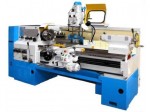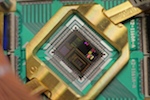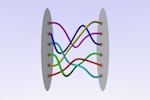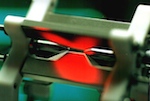
Kai Hudek, Univ. Maryland
A front runner in the pursuit of quantum computing uses single ions trapped in a vacuum.
Quantum computing has long seemed like one of those technologies that are 20 years away, and always will be. But 2017 could be the year that the field sheds its research-only image.
Computing giants Google and Microsoft recently hired a host of leading lights, and have set challenging goals for this year. Their ambition reflects a broader transition taking place at start-ups and academic research labs alike: to move from pure science towards engineering.
“People are really building things,” says Christopher Monroe, a physicist at the University of Maryland in College Park who co-founded the start-up IonQ in 2015. “I’ve never seen anything like that. It’s no longer just research.”
Google started working on a form of quantum computing that harnesses superconductivity in 2014. It hopes this year, or shortly after, to perform a computation that is beyond even the most powerful ‘classical’ supercomputers — an elusive milestone known as quantum supremacy. Its rival, Microsoft, is betting on an intriguing but unproven concept, topological quantum computing, and hopes to perform a first demonstration of the technology.
The quantum-computing start-up scene is also heating up. Monroe plans to begin hiring in earnest this year. Physicist Robert Schoelkopf at Yale University in New Haven, Connecticut, who co-founded the start-up Quantum Circuits, and former IBM applied physicist Chad Rigetti, who set up Rigetti in Berkeley, California, say they expect to reach crucial technical milestones soon.
Academic labs are at a similar point. “We have demonstrated all the components and all the functions we need,” says Schoelkopf, who continues to run a group racing to build a quantum computer at Yale. Although plenty of physics experiments still need to be done to get components to work together, the main challenges are now in engineering, he and other researchers say. The quantum computer with the most qubits so far — 20 — is being tested in an academic lab led by Rainer Blatt at the University of Innsbruck in Austria.
Whereas classical computers encode information as bits that can be in one of two states, 0 or 1, the ‘qubits’ that comprise quantum computers can be in ‘superpositions’ of both at once. This, together with qubits’ ability to share a quantum state called entanglement, should enable the computers to essentially perform many calculations at once. And the number of such calculations should, in principle, double for each additional qubit, leading to an exponential speed-up.
This rapidity should allow quantum computers to perform certain tasks, such as searching large databases or factoring large numbers, which would be unfeasible for slower, classical computers. The machines could also be transformational as a research tool, performing quantum simulations that would enable chemists to understand reactions in unprecedented detail, or physicists to design materials that superconduct at room temperature.
“I tell my students that 2017 is the year of braiding.”
There are many competing proposals for how to build qubits. But there are two front runners, confirmed in their ability to store information for increasingly long times — despite the vulnerability of quantum states to external disturbance — and to perform quantum-logic operations. One approach, which Schoelkopf helped to pioneer and which Google, IBM, Rigetti and Quantum Circuits have adopted, involves encoding quantum states as oscillating currents in superconducting loops. The other, pursued by IonQ and several major academic labs, is to encode qubits in single ions held by electric and magnetic fields in vacuum traps.
John Martinis, who worked at the University of California, Santa Barbara, until Google hired him and his research group in 2014, says that the maturity of superconducting technologyprompted his team to set the bold goal of quantum supremacy.
The team plans to achieve this using a ‘chaotic’ quantum algorithm that produces what looks like a random output (S. Boixo et al. Preprint at https://arxiv.org/abs/1608.00263; 2016). If the algorithm is run on a quantum computer made of relatively few qubits, a classical machine can predict its output. But once the quantum machine gets close to about 50 qubits, even the largest classical supercomputers will fail to keep pace, the team predicts.
The results of the calculation will not have any uses, but they will demonstrate that there are tasks at which quantum computers are unbeatable — an important psychological threshold that will attract the attention of potential customers, Martinis says. “We think it will be a seminal experiment.”
But Schoelkopf does not see quantum supremacy as “a very interesting or useful goal”, in part because it dodges the challenge of error correction: the ability of the system to recover its information following slight disturbances to the qubits, which becomes more difficult as the number of qubits increases. Instead, Quantum Circuits is focused on making fully error-corrected machines from the start. This requires building in more qubits, but the machines could also run more-sophisticated quantum algorithms.
Monroe hopes to reach quantum supremacy soon, but that is not IonQ’s main goal. The start-up aims to build machines that have 32 or even 64 qubits, and the ion-trap technology will enable their designs to be more flexible and scalable than superconducting circuits, he says.
Microsoft, meanwhile, is betting on the technology that has the most to prove. Topological quantum computing depends on excitations of matter that encode information by tangling around each other like braids. Information stored in these qubits would be much more resistant to outside disturbance than are other technologies and would, in particular, make error correction easier.
No one has yet managed to create the state of matter needed for such excitations, let alone a topological qubit. But Microsoft has hired four leaders in the field, including Leo Kouwenhoven of the University of Delft in the Netherlands, who has created what seems to be the right type of excitation. “I tell my students that 2017 is the year of braiding,” says Kouwenhoven, who will now build a Microsoft lab on the Delft campus.
Other researchers are more cautious. “I am not making any press releases about the future,” says Blatt. David Wineland, a physicist at the National Institute of Standards and Technology in Boulder, Colorado, who leads a lab working on ion traps, is also unwilling to make specific predictions. “I’m optimistic in the long term,” he says, “but what ‘long term’ means, I don’t know.”
- Nature
- 541,
- 9–10
- ()
- doi:10.1038/541009a
 4 New Concepts in Technologies*
4 New Concepts in Technologies*


